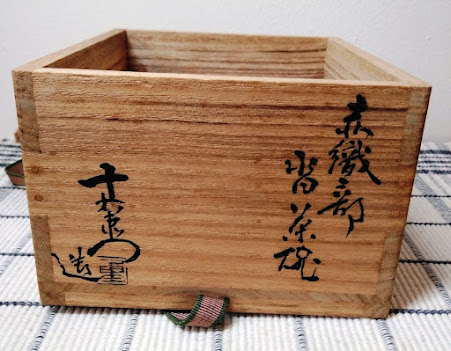184. KATŌ Jūemon 加藤十右衛門,1894-1974, aka Oribe kutsu cha kata 赤織部沓茶況 (red Oribe clog-shaped teabowl)
Katō was most closely identified as a potter with Mino-ware, but he also pursued other traditional styles such as Iga, kuro Oribe (black Oribe), and ki Seto (yellow Seto), leaving behind many masterpieces, particularly teacups and mizusashi (traditional water containers). His eldest son Hoemon, second son Koemon and third son Yaemon, all inherited his business and learned their craft from him. He was born in Kasahara-cho, Toki-gun (currently Tajimi City), Gifu Prefecture.
Supplied with a stamped cloth and original box signed by Sen Sōshitsu XV 十五代千宗室, fifteenth grand master (Iemoto) of Urasenke Tea School (b. 1923; served as grand master from 1964 to 2022).
This was made in the Narumi-style of red Oribe (see item no. 217 for an explanation).
Light red and white clays. Glazed with Oribe green, cream, red, and brown glazes; foot ring and most of the angled area above the foot ring left unglazed. Weight: 388 g (14 oz). Width at rim: 10.2 x 14 cm (4 x 5-1/2 in). Height: 6 cm (2-3/8 in).
This sits on the foot ring, which is a rough circle, approximately 5.6 cm (2-1/4 in) in diameter and 1 cm (3/8 in) high. The interior has been hollowed out to about two-thirds of this distance. Above the foot, the walls slant outward in a straight line at about a 30-degree angle to a height of 1.3 cm (1/2 in). This area is a rough oval. The artist’s mark, the character for “ten” 十, was impressed into this area just above the foot ring (see the third picture from the bottom). Above this the walls rise upward in roughly a straight vertical line. Just above the break between the angled portion and the straight sides, there is concave crease around the entire circumference of the bowl. About 1.3 cm (1/2 in) down from the rim is another crease in the exterior walls around the entire circumference. The rim is a rough triangle with rounded joints where the sides of the triangle meet. The interior of the bowl follows the shape of the exterior, but the walls were smoothed out. Both the glazed and unglazed portions of this are quite smooth. There are a few hairline cracks in the unglazed portion of the exterior (also visible in the third picture from the bottom).
The glazes used here are typical of Oribe but with more red in the mix than on much Oribe ware. On one side, the glazes have absorbed carbon, and the red glaze has turned gray and the green glaze looks bluish. This may have been the side of the pot facing the flow of heat and soot in the kiln (see the sixth and seventh pictures). Most of the underside was left unglazed; there is a line of red glaze along one side, and a teardrop of green glaze formed on the opposite side. The sides are decorated with cream shapes outlined in brown. The interior has a group of similarly drawn squares as well as an arrow made with the brown glaze. The rim was dipped in the green glaze, which was maneuvered to form several teardrops on both the exterior and interior walls.
The
side of the box (next-to-last picture) is inscribed (in three lines, from right to left:
On the underside of the lid (last picture) are the characters (in three lines): 織部 (Oribe); 茶碗 (chawan); and a third line I can’t decipher, but which is undoubtedly Sen’s signature. The final character may be his kaō 花押 sigil (stylized form of signature used by tea practitioners.)
A very special teabowl.
Purchased from Treasures of Old Times in Bangkok in 2022 (invoice).














No comments:
Post a Comment